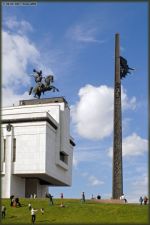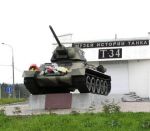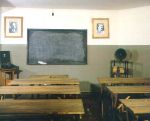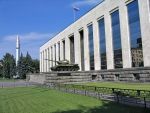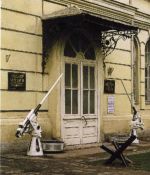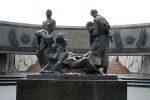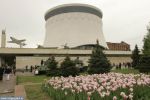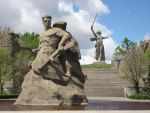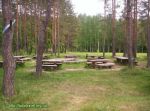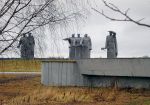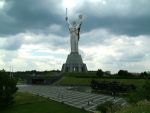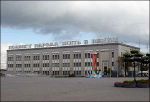Central Museum of the Great Patriotic War of 1941-1945
Address: 3, Victory Square, Moscow, 121170, Russia Directions: Park Pobedy metro station, or land transportation to the Poklonnaya Gora stop Website: http://www.poklonnayagora.ru/ In honor of Victory in the Great Patriotic War of 1941-1945, on May 9, 1995 in Moscow in Victory Park on the Poklonnaya Gora opened the Central Museum of the Great Patriotic War of 1941-1945, which became the center of the Victory Memorial Complex. The museum includes military history exhibition, depicturing the chronicle of the war years, and the artistic one. Six dioramas on the most important battles of the war are the pride of the museum. The peculiarity of the exhibition is audio-visual system, demonstrating genuine newsreels of the war years, rare photos, maps and archival materials. The museum is equipped with an automated system to find information about the fallen during the Great Patriotic War — The Book of Memory. The museum exhibition also spreads in Victory Park, where an exhibition of military equipment and engineering fortifications of the Great Patriotic War and World War II is hosted. Rare specimens of trophy machinery are also represented. The magnitude of the history timeliness, diverse and technically equipped exposition, a variety of collections, rich scientific library – all of these allow the museum to occupy a special place among others military history museum centers of Russia.
History of the T-34 museum complex
Website: http://www.museum-t-34.ru/ The museum reflects the process of creating a medium tank T-34, represents the people for many years, the former top secret. Submitted heroes-tanks and the history of their exploits during the Great Patriotic War and World Wars. For the first time covered topic of tactical and strategic role of the T-34 tanks in the battle of Moscow, shows the comparative characteristics of medium tanks from different countries, can be traced in detail "family tree" of the T-34 and its "geography". Collected numerous statements about the T-34 and its role in World War II.
Address: 15, Narodnogo Opolcheniya St., Krasnogorsk, Moscow region, 143400, Russia Directions: Tushinskaya metro station, a bus number 542 or Auto Express and Autoline to the stop “Narodnogo Opolcheniya St”. Website: http://www.museum.ru/M464
In 1985 on the initiative of the GDR, Memorial Museum of German anti-fascists was established in Krasnogorsk. The exhibition was launched in the former building of Central School of fascism. During the Great Patriotic War and in post-war years a special operational and transit encampment number 27 for war prisoners was located in Krasnogorsk.
This officer’s operational and transit encampment was unique in many regards. The only camp that was directly subordinate to the central agency - the NKVD of the USSR. Almost 9 years of existence the encampment met about 50 thousand people, representing over 20 nationalities of Europe, as well as Japan, most of which were high-ranking prisoners.
Krasnogorsk encampment became the center of the formation and development of German anti-fascist movement of war prisoners. Here, in July 1943, Free German National Committee – an anti-fascist organization composed of German war prisoners and political refugees – was founded at the constituent conference. From the spring of 1943 to 1950, the anti-fascist Central School worked on the buds of the encampment. It graduated more than 6000 people, five thousand of whom were Germans. In addition to them, the school hosted Hungarian, Italian, Romanian war prisoners, as well as representatives of other nationalities.
Krasnogorsk war prisoners constructed buildings of the State Film and Photo Archive (designed by a German prisoner of war, architect P. Spiegel), the building of secondary school № 1, six houses and three residences for the workers of the optical plant, as well as a stadium in Moscow. Prisoners of encampment number 27 served the Dynamo stadium. Krasnogorsk encampment was widely known for its shops. Gathered here masters and professionals in various spheres from repaired and restored cars, produced expensive furniture for government agencies, sanatoriums and rest homes.
In the apparel and shoe shops of the customer’s material they made clothes and shoes for the higher ranks of Ministry of the Interior and Ministry for the Foreign Affairs, the staff of the Pravda newspaper, the artists of Moscow theaters. About a thousand prisoners, including more than five hundred Germans, were buried in Krasnogorsk cemetery. Most of them died during the war, when prisoners’ mortality was much higher than in the postwar years. One of the cemeteries survived to this day. It is landscaped and available for visits to all comers.
Central Museum of Armed Forces
Address: 2, P.O.B. 125, Soviet Army St., 129110, Moscow Directions: From Novoslobodskaya metro station, then trolleybus 69, or Tsvetnoy bulvar St., trolleybuses 13, 69 Website: http://www.cmaf.ru
The museum represents the military-historical themes. Its funds and exposures estimate about 800 thousand units. These are battle and captured flags of the Civil War and World War II, documents, paintings, photonegative collection, weapons, decorations; personal belongings of members of the Russian armed forces. In the open air the museum exhibits 150 pieces of military artillery, armor, missile, aircraft, naval weapons and equipment, from guns and tanks of the Civil War to modern tactical and strategic missiles, missile-carrying aircraft and air defense systems.
State Memorial Museum of Defence and the Siege of Leningrad
Address: 9, Solyanoy Pereulok St., St. Petersburg, 191028, Russia Directions: All types of transport to the Summer Garden or Pestel St. Website: http://www.museum.ru/M107 The State Museum of Defense and the Siege of Leningrad is a unique cultural and educational institution which activities are entirely devoted to the history of Leningrad Battle of World War II. Documents and personal belongings of the Great Patriotic War are exposed there. They show the courage and heroism of those who defended Leningrad.
Monument to the Heroic Defenders of LeningradAddress: Victory Square, St. Petersburg, 196143, Russia Directions: Moskovskaya metro station Website: http://www.museum.ru/M130 Monument to the Heroic Defenders of Leningrad was opened on May 9, 1975 to the 30th anniversary of Victory in the Great Patriotic War. The authors of the memorial complex laureates of the Lenin State Prize are the People's Artists of the USSR, S. Speransky and V. Kamensky, M. Anikushin. A unique exhibit is a memorial hall. The area of 1200 square meters represents real documents and exhibits reflecting the city defenders’ feat - soldiers and civilians during the 900-day siege. The hall demonstrates two documentaries, electrified map Heroic battle for Leningrad runs. The hall is decorated with two mosaic panels Blockade and Victory.
The Battle of Stalingrad State Museum-PanoramaAddress: 47, Chuikov St., Volgograd region, Volgograd, 400053, Russia Directions: From the station — trams, trolleys 8, 8a, 1, 12; bus 23; taxi — to the Lenin Square stop Website: http://panorama.volgadmin.ru/ The museum complex is dedicated to one of the decisive battles of the Second World War — the Battle of Stalingrad, which marked the beginning of radical change in the war. It includes the largest panoramic view in Russia, The defeat of Nazi forces at Stalingrad. The museum displays photographs, documents, things of war, including the relics: Stalingrad soldier’s sniper rifle, greatcoat of General V.A. Glazkov with 160 bullet and shrapnel shell-holes; the Komsomol and party tickets with bullet markings, drenched in blood; fighting banners of units defending Stalingrad; personal kits of outstanding commanders, their portraits (Zhukov and others). The honorable sword — a gift of King George VII of England to the citizens of Stalingrad (1943) and many other gifts and messages from more than 60 countries resemble the hero-city on the global appreciation of the peoples of the world. The museum is an important center of patriotic and moral education of young generations; it carries great scientific and research work. Major city, Russian and international actions on issues of convergence and mutual understanding are held on the basis of the museum. Since 1982 the museum has been visited by 14 million people. The modern building of the Museum-Panorama was designed by the Institute “Volgograd civil project” (Decree of the Council of Ministers of the RSFSR № 750 of June 12, 1966). The authors of the project: People’s Architect of the USSR, V. Maslyaev - lead author; designer E. Temnikov, architect V. Trostyanskaya, engineers G. Sysoev, M. Blayneys. It is built in the central part of the city of Volgograd in the historic place of landing of the 13th Guards Rifle Division of General A.I. Rodimtsev. Under the enemy fire the division crossed the Volga in September 1942, and fought heroically in the battle of Stalingrad to the victorious conclusion. The building is constructed in accordance with the terrain - on two levels. On the first level there is the Museum Storage Facility, and the administrative part of the complex. This level is crowned by a platform on which the building of the panorama is erected and placed a permanent exhibition of military equipment during World War II: tanks, self-propelled guns, aircraft, howitzers, cannons, "Katyusha", a field kitchen. The complex includes a historical monument, Ruins of the mill, a monument to the sailors of the Volga Flotilla, a monument to the civilians of Stalingrad, died on August 23, 1942; the monuments to prominent generals Zhukov, Chuikov; tank tower, signifying the cutting edge of the Soviet defenses on November 19, 1942, as well as thematically linked to other memorable places the Battle of Stalingrad —Wall of Rodimtsev, and House of Pavlov.
Historical Memorial Complex to Heroes of the Battle of Stalingrad on the Mamayev Hill
Website: http://mamayevhill.volgadmin.ru/ Monument to Heroes of the Battle of Stalingrad on the Mamayev Hill is world famous; this is the most visited monument in the country. Two hundred days and nights lasted the battle of Stalingrad; about 140 days fighting for the main height of Russia – the Mamayev Hill – did not cease. No accident that there was erected a majestic monument, The Motherland calls. Numerous tourists every year visiting the memorial do not remain indifferent to the sacred memory of the heroic defenders of Stalingrad.
Historical and Memorial Museum of the Central Front
Website: http://www.museum.ru/M699 In 1943, during preparation and during the Battle of Kursk, the headquarters of the Central Front under K. Rokossovsky was located in Svoboda. On August 5, 1973, to the 30th anniversary of the victory at Kursk, in Svoboda was open a memorial complex, and on May 9, 1975 — Museum of the Central Front. The museum exposition acquaints visitors with the content and scope of organizational activities of the command of the Central Front during the Battle of Kursk. Here are the documents, personal belongings of the officers and common soldiers. Numerous materials illustrate the breadth, scope and historical significance of the battle. Within the complex area of 7.1 ha, the guns, T-34 tank, sculptural and architectural complex are also exhibited, dug-out of Rokossovsky is restored.
Museum of the History of the partisan movement in Bryansk
Website: http://www.museum.ru/M691 The museum is located on a meadow by the river Snetet. The composition of the memorial complex includes a marble memory wall with the names of the dead partisans on bronze plates and symbolic bronze sculptures. This exhibition of the museum was made on a high artistic level in 1994; it reflects the main stages of the guerrilla movement in the Bryansk region in 1941 - 1943. It represents personal things, awards, weapon of partisans. Voiced diorama Explosion of the Blue Bridge depicts an episode of the most famous guerrilla operation.
The Guardsmen’s MemorialAddress: Nelidovo village, Volokolamsk district, Moscow region, 143628, Russia Directions: From Riga train station to the Dubosekovo stop, then walk to Nelidovo village, or by car go ahead Volokolamsk highway to the village Nelidovo Website: http://www.museum.ru/M468 The museum has preserved the objects associated with the names of I.V. Panfilov, V.G. Klochkov, I.D. Shadrin; memories of Panfilov’s men (Panfilov’s twenty-eight guardsmen), newspaper files, letters from the front (the originals), numismatics, photography and other sacred relics. Feat of the soldiers of the 4th squadron at the river Dubosekovo is immortalized in stately monument erected in May 1975, to the 30th anniversary of Victory. The common grave is situated also in Nelidovo village.
The National Museum of the Great Patriotic War of 1941-1945 Memorial ComplexAddress: 44, Ivan Mazepa St., Kiev, 01015, Ukraine Directions: Arsenalnaya metro station, bus № 24 or trolleybus № 38 - Museum of the Great Patriotic War stop (terminal). Website: http://warmuseum.kiev.ua/ Modern exposition of the museum was founded in October 1994 — May 1995, the priority one is the Ukrainian subject, Ukraine’s contribution to the great victory over Nazism. Considerable attention is paid to other parts of the Soviet-German front, large-scale battles of the Great Patriotic War, the establishment and operation of the anti-Hitler coalition, the heroism and sacrifice of the soldiers and commanders. The main exhibition occupies 16 halls with total area of 5 thousand square meters; it contains over 15 thousand exhibits. A feature of the display is a presentation of historical material by creating a readily perceptible symbols and images. The exposition of all the halls is thematically and chronologically united by the accent core “The Road of War”, where with the help relics is created an art-historical image of each topic, which is revealed, is concretized and is complemented in the windows of an appropriate room.
Belarusian State Museum of the Great Patriotic WarAddress: 25a, Nezavisimosti prospect, Minsk, Belarus Website: http://www.warmuseum.by Belarusian State Museum of the Great Patriotic War is the largest repository of relics of the Great Patriotic War and one of the most important centers of civic and patriotic education in Belarus. Museum’s funds include some 142 thousand units; that is the richest material for the study of military history. It is used to show the exposure of the mass of patriotic events, and to research materials of the war. |

